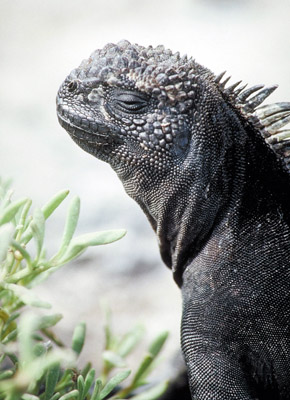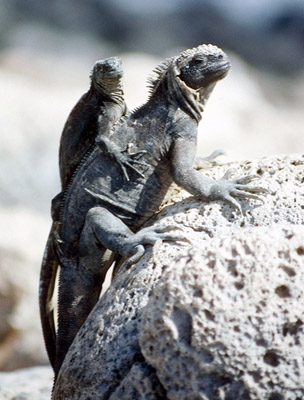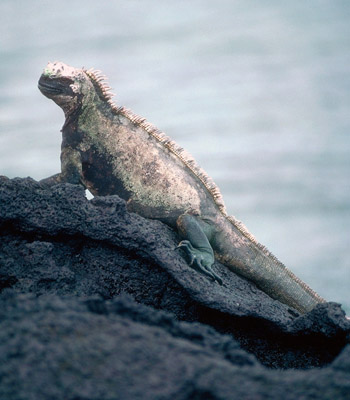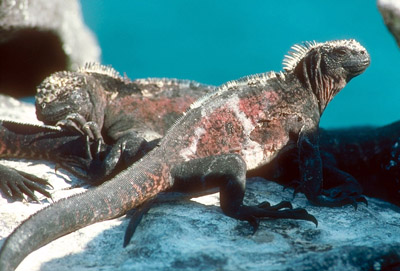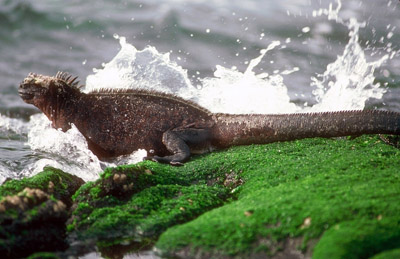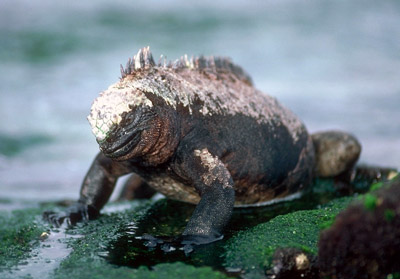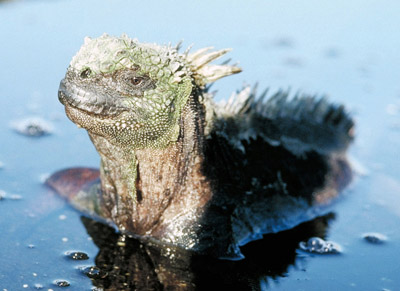The Galapagos Islands are the only place in the world where Marine Iguanas, sea-going lizards are found. They live throughout the islands and consist of seven distinct races varying in size and colouration that live on the different islands.
Marine Iguanas are the only lizards that they feed in the sea on algae, they warm up on volcanic rocks in the sun before diving down up to 10m (33 feet), they can remain submerged for about 10 mins though usually stay within 50m (165 feet) of the shore.
Marine Iguanas - Amblyrhynchus cristatus
Profile - Animals of the Galapagos
The Marine Iguana is one of the Galapagos' unique animals. They remind one of some sort of "Lost World" creature, with a spiky crest from the head all the way to the tail and some subspecies, the males in particular developing red or red and green colouration during the breeding season. They can sometimes appear to have some kind of growths on the skin due to the changes in colouration (but they don't).
Galapagos marine iguana facts Basics
Weight: The largest on the island of Isabela can grow up to 12 - 13kg (26 - 29 lbs), the smallest on the island of Genovesa reach 1 - 2kg (2.2 - 4.4 lbs.), there is significant sexual dimorphism with adult males being about 70% larger than adult females.
Length: up to 1.3m (4.3 feet) for the largest from Isabela, up to 75cm (2.5 feet) for the smallest on Genovesa.
Note - There are seven races of marine iguanas in the Galapagos all belonging to the same species, they differ in appearance and/or size according to race and which island they live on.
Breeding Season: December to January, varies a little according to the island. One to six leathery shelled eggs are laid in March and April at the end of a 1m burrow excavated by the female, they hatch three to four months later. Young marine iguanas are about 10cm long at hatching and almost completely black. Males are selected by females according to body size on breeding grounds called leks that the males defend against others. The best young survival rates come from a breeding between larger males with larger females.
Estimated world population: - Despite the fact they are only found on the Galapagos Islands, the numbers are unknown, population estimates range from 50,000 to hundreds of thousands. The population can be significantly affected by a strong El Nino year which reduces food supply, larger individuals are more likely to die during these events, the cyclic population size correlated with El Nino makes estimates difficult and explains the wide variation in estimates.
Feeding: Mainly herbivorous largely on green and red algae found in the inter-tide zone at low tides or just off shore which they dive for. They have also been known to eat the faeces of sea lions and crabs. Off shore diving (no further out than 50m generally) is something only the larger males do, no more than around 5% of the total population do this.
Conservation status: Vulnerable. It is thought that the population has declined over the years, having evolved in isolation, marine iguanas are not good at dealing with new enemies such as pigs, dogs and cats introduced by humans, they are also susceptible to introduced diseases.
Distribution: Throughout the Galapagos Islands and no-where else.
Predators: Eggs and youngsters are very vulnerable, especially when newly hatched, they are predated on by native predators such as hawks, snakes, frigatebirds and herons, introduced cats and dogs also prey on eggs and youngsters, in the sea they face moray eels and other large fish. If they make it to adulthood they are much safer, though cats, dogs and hawks are still a danger depending on their size.
What are Galapagos Marine Iguanas Like?
These marine lizards fascinated the young Charles Darwin, on his visit to the Islands on board the Beagle, he grabbed one by the tail and swung it out into the ocean. It swam back. He repeated the exercise until he deduced that on land, the iguana faced no predators, but in the sea, unknown dangers lurked; though fully equipped to swim, the iguana found safety on shore. Note - do not try this today!
As the lizards feed at sea and are cold blooded like all reptiles, they must spend a considerable time basking on the dark larva rocks, particularly as the seas around the Galapagos can be quite cold, this limits the time that they can spend in the water.
They live mainly on land but feed in the inter-tidal zone, only the larger males swim in the sea and dive to feed, an act that involves a degree of risk. The sea is cold and they are cold blooded animals, before they go to sea, they must warm up on the warm rocks in the sun. When sufficiently warm they have a limited time to swim, dive, feed and return again. If they leave it too long, their body temperature could fall to a point where they cannot swim any longer when they would be swept away and drown, the larger the individual the more slowly they will cool down once warmed up. Once returned from their swim, the iguanas need to warm up again, they are quite slow and sluggish at this time making them more vulnerable to predation.
Feeding on marine algae gives the iguanas a large intake of salt, the excess of which is spat out through their nostrils, along with a snorting noise - the only sound they make.
How did the Galapagos get to have Marine Iguanas?
Marine iguanas are thought to have separated from land iguanas about 8 million years ago, the Galapagos as a whole are older than this, but none of the current islands are, so implying that the marine iguanas evolved on one of the now submerged parts of the Galapagos archipelago. The marine iguanas evolved to fill a niche that elsewhere in the world is filled by some other type of animal, in the absence of any natural competitors, once again the Galapagos gained a unique and unusual kind of animal that is found no-where else.
There are also land iguanas on the Galapagos which can interbreed with their marine neighbours to produce a hybrid occasionally where the ranges overlap. They are distinct species though this indicates that they are evolutionarily quite closely related.
The marine iguanas have evolved a number of adaptations to their lifestyles such as blunt noses to allow them to easily graze seaweed, a tail that is flattened from side to side (laterally) to make it more efficient when swimming, powerful limbs and claws for hanging onto rocks by the sea shore and those glands to spit out the excess salt that they take in due to their diet.
Top banner credit - NOAA.

